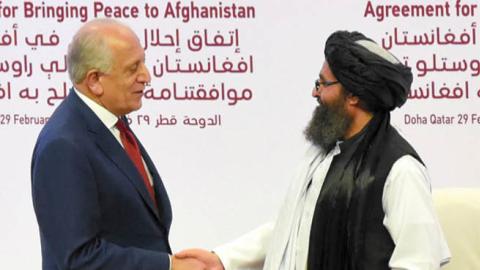The weeklong test period with the Taliban for a meaningful “reduction in violence” (RIV) seems to have measurably cut the Taliban’s violence by about 80 percent. Barring any major violations of the RIV terms, the finalized U.S.-Taliban deal is expected to be inked on February 29 in Doha, Qatar.
Concurrently, the U.S. will announce its joint declaration with the Afghan government and reaffirm America’s commitment to Afghanistan. Within weeks, intra-Afghan negotiations are expected to convene, allowing the Taliban and the warring parties to engage in serious talks to determine Afghanistan’s future.
Throughout the intra-Afghan talks, the RIV terms would not only remain in effect but slowly stretch beyond the 80 percent violence reduction target until a formal ceasefire is negotiated. This includes the Taliban's commitment to cease suicide, roadside or rocket attacks and to avoid assaults on cities, population centers and major infrastructure. Meanwhile, the U.S. and Afghan forces will refrain from offensive operations against them.
These seem to be important steps, which have created a great deal of optimism about ending America’s longest war. But reality in Afghanistan never unfolds as smoothly as theoretical frameworks and carefully crafted diplomatic memoranda might suggest. Much can go wrong in the test period as well as in intra-Afghan negotiations.
The Taliban have been consistently reluctant to accept the legitimacy of Afghanistan’s government. The controversy over the results of recent presidential elections, which gave President Ashraf Ghani a second term, seems to have subsided. But the inauguration for Ghani’s second term had to be postponed at the suggestion of the U.S. secretary of state, Michael Pompeo, to prevent it from over-shadowing the U.S.-Taliban deal.
Moreover, most Afghans and many outside the Trump administration rightly remain wary of the Taliban’s promises and intentions. The group’s basic beliefs, its conduct while in power before 9/11 and its failure to keep its promises in the past are all grounds for circumspection.
Moreover, the Taliban appear more fragmented now than they were during the brief ceasefire in 2018, raising serious questions about the group’s ability to deliver on expectations and show complete control over their forces and factions. Chief among the potential spoilers of any agreement are the Taliban’s military hardliners – primarily the Haqqani Network – whose compliance of the agreement depends on Pakistan’s ambiguous role in the process.
Since the 1970s, the Haqqani Network has been active in trench warfare in Afghanistan, operating out of its strongholds in Pakistan and eastern Afghanistan. At the time, the group sought to topple the regime of Afghanistan’s first president, Daoud Khan, a nationalist who resisted regional meddling in Afghan affairs.
After fighting the Soviets during the 1980s as part of the U.S.-backed Mujahideen, the group aligned closely with al Qaeda in the 1990s and allowed al Qaeda to establish its first camps in Haqqani territory in Afghanistan. The group’s founder, Jalaluddin Haqqani, served as a minister in the Taliban regime and its current head, Siraj Haqqani, is now the deputy leader of the Taliban.
The Haqqani Network has been a sworn U.S. enemy since 2001 and has become a prolific killer of American and Afghan forces. The group controls nearly 25 percent of the Taliban’s fighting force and hardliners, operating almost independently with its own centralized decision body, military sub-commands, local alliances and funding.
It is arguably the richest of the Taliban factions, operating a lucrative mafia-like criminal enterprise to include extortion, kidnapping for ransom, drug trafficking, protection rackets, front companies for money laundering schemes and foreign donations.
The principal driver behind the Haqqanis money and muscle is its close client-patron relationship with Pakistan. As a result, the group’s leaders own properties in Pakistani cities, enjoy safe houses, operate madrassas, collect donations, freely travel abroad, seek treatment in local hospitals and frequently manage to get their supplies to pass unimpeded between Afghanistan and Pakistan.
Today, even though a senior Haqqani member is part of the Taliban negotiating team in Doha, the group has no military reason to stop fighting. Although Siraj Haqqani’s by-line appeared on a New York Times opinion article proclaiming the Taliban’s desire for peace, the Haqqanis harbor a profoundly different vision for Afghanistan than do the moderate Taliban members.
Chances are that the Haqqani Network is set to play a disruptive role in the evolving peace process by continuing its targeted violence and pushing for the release of thousands of Taliban prisoners. Careful planning for drafting and implementing an agreement with the Taliban should not detract Americans from controlling the spoiler’s role.
Read in The Hill

















